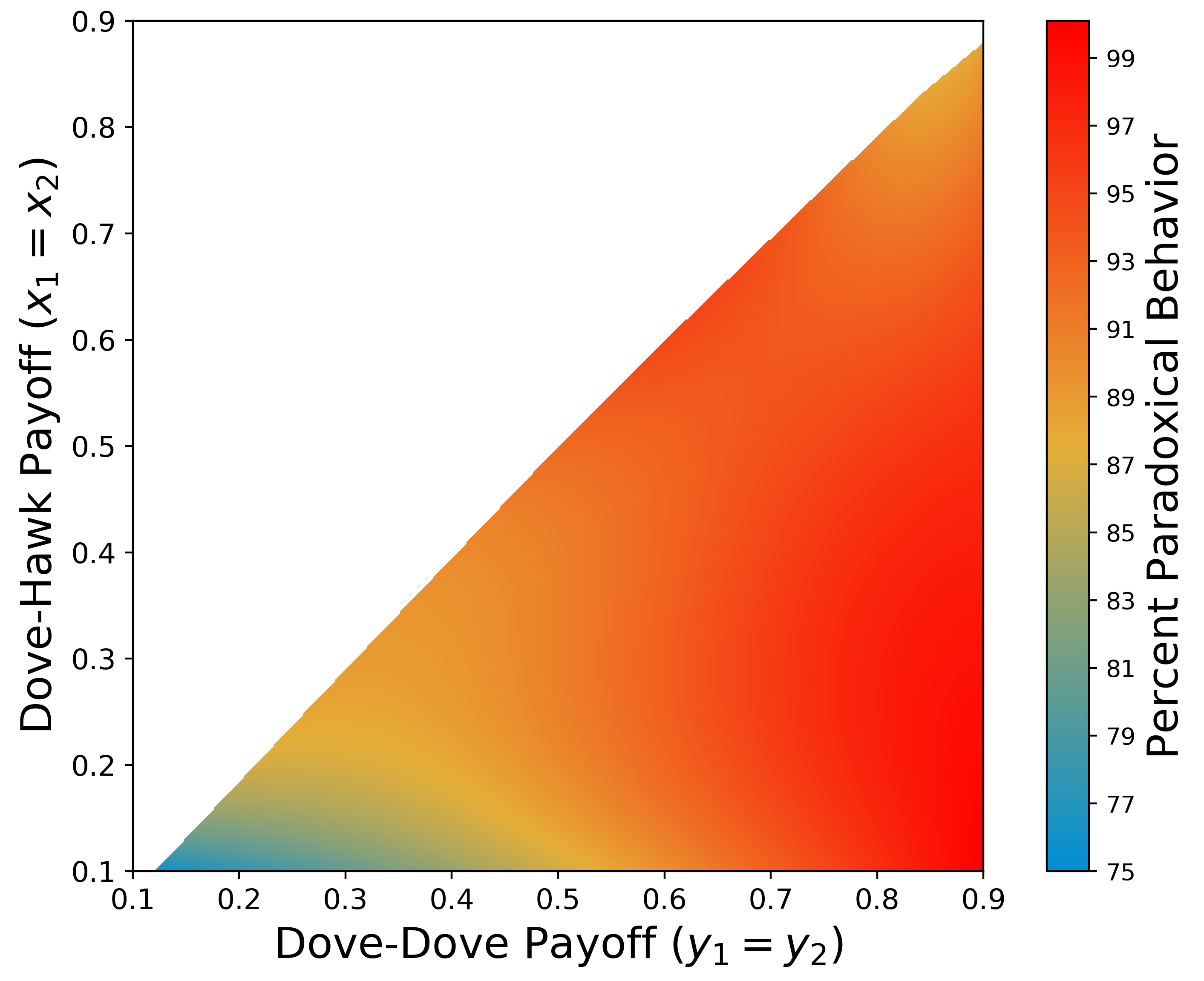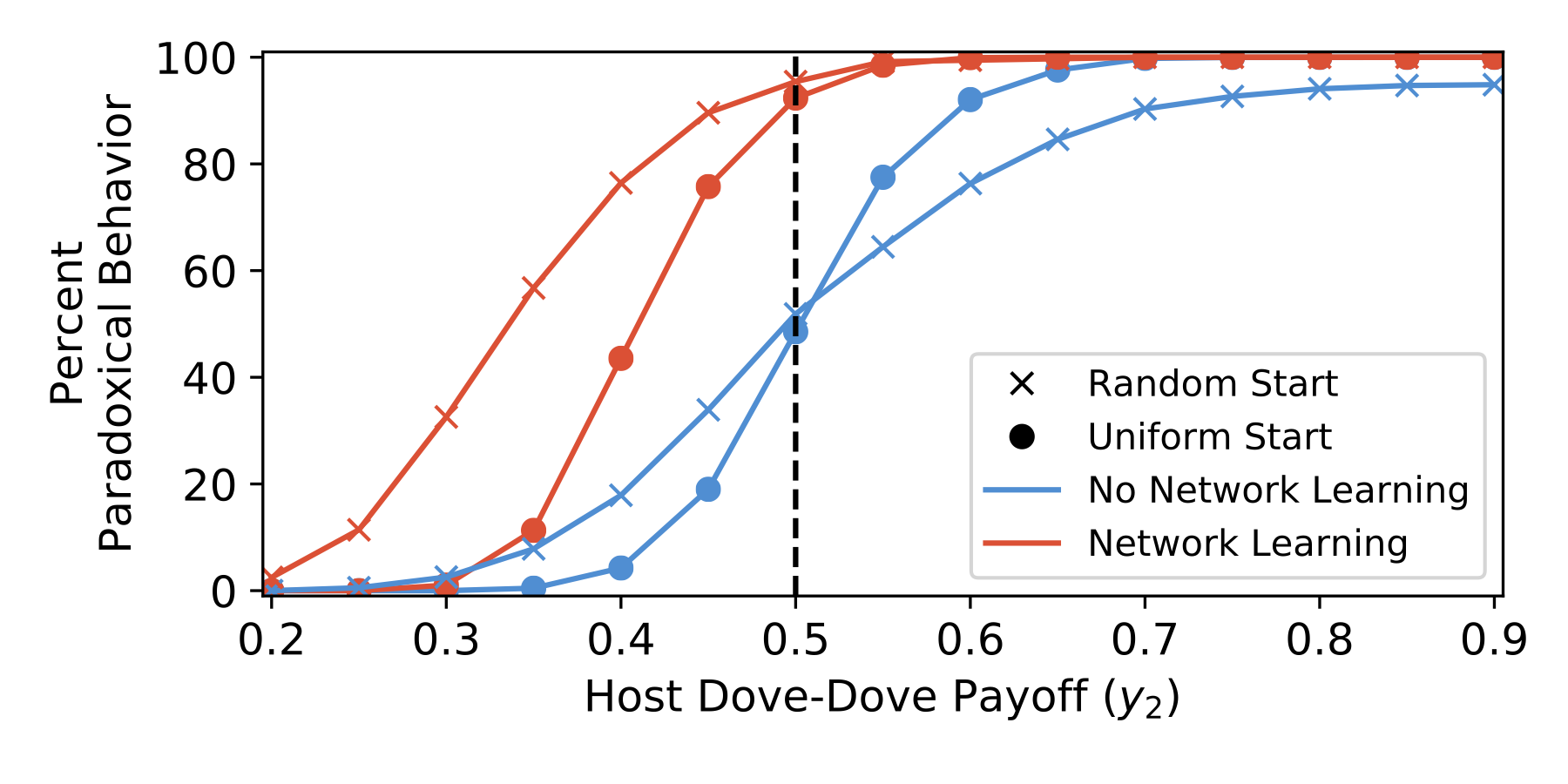Conflict and Convention
in Dynamic Networks
Journal of the Royal Society Interface, 15(140), 20170835, 2018
Understanding how cooperation emerges and persists is a fundamental problem in social and economic systems and many solutions to this problem depend critically on resolving conflicts efficiently. An important way to resolve conflicts involves adopting a convention: a that avoids any conflict between aggressive strategies. Dynamic networks allow individuals to resolve conflicts by managing their network connections rather than changing their strategy. Using computer simulation, we show that outcomes associated with host-guest norms (play aggressive away, not at home), rather than ownership norms (play aggressive at home, not away), tend to evolve on dynamic networks.
We study the hawk dove game to explore the dynamics of conflict and cooperation, where hawks act aggressively, and doves cooperatively. We use a coevolutionary model where both network
ties and behavioural strategies evolve by reinforcement learning. In a dynamic network environment, host-guest norms (paradoxical behavior) account for the vast majority of the final state solutions, while ownership norms (bourgeois behavior) are quite rare. Only when payoffs are very strongly biased in favor of playing dove when visiting, or against dove when hosting, do we find the bourgeois solution more often than the paradoxical solution. If there is no bias or any bias in favor of dove when hosting, or against dove when visiting, the paradoxical solution is far more prominent. The paradoxical solution has a large basin of attraction because it can be reached through numerous network configurations, while the bourgeois solution can typically only be reached when the network maintains a high level of homogeneity throughout its evolution.
A common view on the origin of territoriality or norms of ownership takes the evolution and stability of the bourgeois correlated equilibrium to provide a rationale for aggressively defending territories or resolving conflicts over resources in favor of hosts. In stark contrast, our results show that a host-guest norm, where the host concedes resources to a visitor, evolves far more readily than any norm of territoriality. More work is needed to unveil the evolutionary dynamics underlying ownership norms.


Click on the buttons to learn more about the most common evolutionary trajectories in the model. In the network plots here and in the interactive visualization, node size corresponds to total incoming edge weight (expected number of visits). The outer edge color of the nodes corresponds to the visitor strategy, and the node center color corresponds to host strategy. Darker red is more prominent hawk strategy, darker blue is more prominent dove strategy, and light gray is neutral strategy (equal chance of playing hawk or dove). Arrow size on the edges corresponds to the proportion of outgoing edge weight for a single node (i.e. a very large arrow means the source agent almost exclusively visits the target agent).
We created an interactive visualization to accompany the paper that allows you to explore select aspects of our raw data.
First, choose model parameters you want to explore using the dropdown menus. Then, scroll over the line chart to view the proportion of interaction types over time, and the network will update correspondingly. You can also click on the legend markers to toggle them - the default state shows Bourgeois and Paradoxical interactions, while hiding Cooperative and Aggressive interactions. Click while mousing over the chart to "freeze" the network visualization at one particular time step. You can hover over the nodes to see their visitor and host strategy states, and you can drag them around as well.
In the payoff dropbox menu, DD is the dove-dove payoff, and DH is the dove payoff in a dove-hawk interaction. Visitor Bias implies that dove visitor payoffs are larger than dove host payoffs. Static simulations do not allow agents to update their network connections. In all simulations, hawk-hawk payoffs are fixed at 0, and hawk payoffs in hawk-dove interactions are fixed at 1. See Figure 1a in the paper for more payoff details.
@article {Foley20170835,
author = {Foley, Michael and Forber, Patrick and Smead, Rory and Riedl, Christoph},
title = {Conflict and convention in dynamic networks},
volume = {15},
number = {140},
year = {2018},
doi = {10.1098/rsif.2017.0835},
publisher = {The Royal Society},
issn = {1742-5689},
URL = {http://rsif.royalsocietypublishing.org/content/15/140/20170835},
eprint = {http://rsif.royalsocietypublishing.org/content/15/140/20170835.full.pdf},
journal = {Journal of The Royal Society Interface}
}